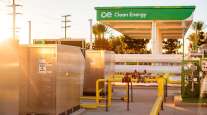Lack of Infrastructure Dampens Promise of Natural Gas as Alternative to Diesel
This story appears in the Nov. 28 print edition of Transport Topics.
WASHINGTON — Natural gas holds a great deal of promise for the trucking industry as an alternative to diesel, but with the hurdles of infrastructure and costs, it’s rarely a viable option currently, trucking stakeholders said.
“Natural gas is a compelling fuel for us from a greenhouse-gas-reduction point of view and a price point of view, if it can be made viable through infrastructure,” Randy Mullet, vice president of government relations at Con-way Inc., said at the U.S. Environmental Protection Agency’s Freight Sustainability Summit.
Mullet said he found a website that maps publicly accessible natural gas fueling stations, but he discovered only one within a 100-mile radius of Washington, D.C.
“The notion that we can make that shift fast is another one of those solution sets that just doesn’t exist,” said Mullet, whose company has operations in the truckload, less-than-truckload and third-party logistics sectors.
Home Depot, the home improvement chain, does not own its trucks but is looking for ways to help or encourage its trucking carriers to use natural gas, said Lindsay Chason, the retailer’s manager of environmental innovations.
“We feel like it’s good to figure out if this makes sense for us, so we can protect our interests from an energy perspective and also be on, hopefully, the leading edge of whatever comes next,” she said.
Chason did not elaborate on what specific steps Home Depot is taking or looking into, but its deliberations have focused on liquefied natural gas.
Con-way’s planning has focused instead on compressed natural gas. The carrier soon will launch a program in which it will introduce CNG-powered trucks to its East Coast less-than-truckload fleet on a regional basis, Mullet said.
A natural-gas-powered truck costs $30,000 to $50,000 more than a similar diesel truck, which costs about $100,000, he estimated, adding that the premium is likely to decrease.
“So it’s a huge capital expense to begin with,” he said. “We’re actually doing [return-on-investment] studies based on a non-incentivized purchase price for the vehicle . . . but our thoughts are that the price will come down eventually.”
Even so, fueling infrastructure is still a major problem for natural gas, Mullet said. Con-way fuels most of its trucks at its own stations, so natural gas would necessitate a whole new infrastructure at a major expense.
Some areas on the West Coast and in Texas have “corridors” of public natural gas stations, Mullet noted.
“If those corridors cover 10% of the miles that we run, we then have to cap that piece of equipment,” he said, adding that the trucks would not be able to travel on other routes. “It really becomes hard for the efficiency of the network to be able to utilize that anyplace else.”
Mullet touched on the issue of federal incentives for purchasing natural-gas trucks, but he warned that they are unlikely to pass if they cost the country money.
Political issues also could hamper the abundance of natural gas, he said.
“We’ve got a lot of natural gas availability, in that we’ve got all these great natural gas finds, but we’ve not fully developed those fields yet,” Mullett said, “and there’s a lot of opposition to developing those fields,” he said.
Shippers are asking many of the same questions, Chason said.
“The major concern is availability,” she said. “There are a lot of fueling stations on the West Coast or in Texas, not a lot beyond that.”
Home Depot has considered building fuel stations for its carriers, but that would come at a large cost, Chason said.




